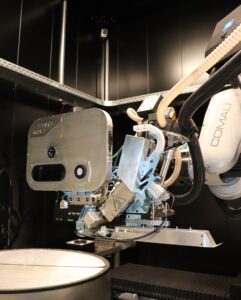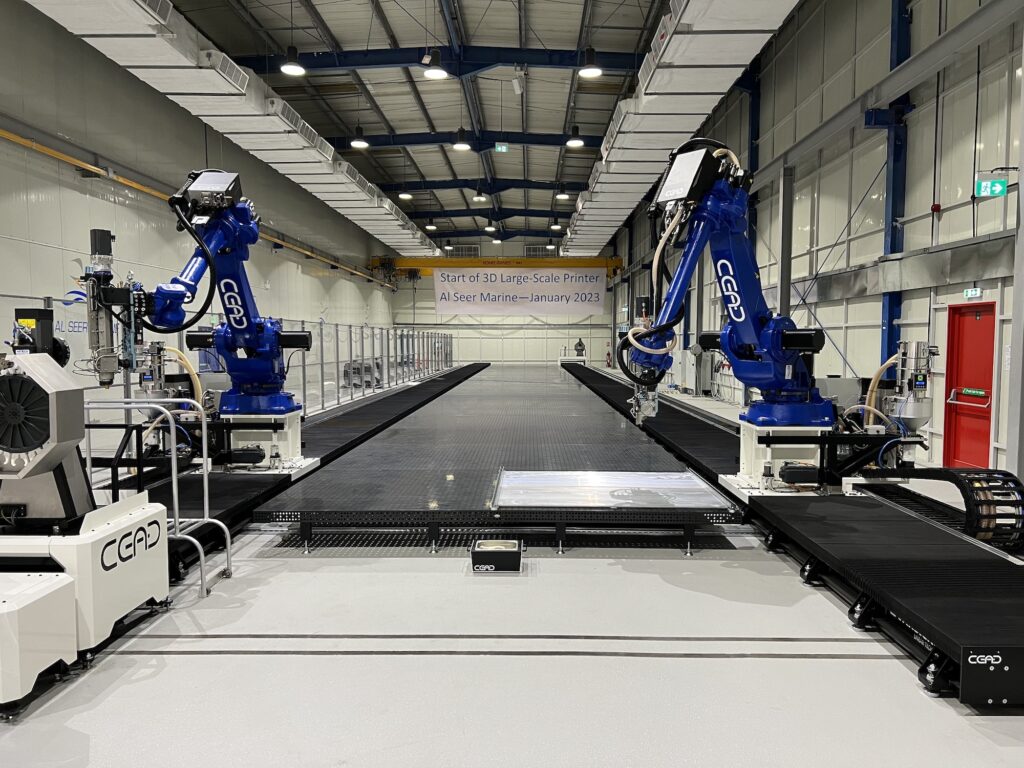
Over the past decade, there has been a clear trend towards digitalization and automation. Currently, the production of most large (composite) parts is still a labor-intensive and time-consuming process. This type of skilled labor and expertise is hard to find and many companies therefore outsource part of their production to different parts of the world. Manufacturers are seeking solutions that allow them to bring production processes back in-house while concomitantly automating their business operations. The overall goal is to shorten lead times, save money on transports, reduce environmental footprint and to minimize the risk of global conflicts affecting their entire organization.
This is why CEAD set out years ago to develop a solution to simplify and minimize the number of steps in the production chain, designing and delivering a complete robot solution to produce large format parts with composite materials. The purpose of the Flexbot is to serve different client’s in a wide range of industries, it therefore goes beyond large format 3D printing. It is a hybrid robot-based solution that can switch to a CNC spindle where calibration methods are used to reach the required high accuracies and tolerances. Flexibility is one of the key features that characterizes robot-based 3D printing and milling, enabling the production of complex geometries which would otherwise be difficult or impossible using traditional methods.
CEADs partners are experts in their field and thus their feedback is highly valuable and essential for innovation. Since the early days, the company closely collaborates with renowned universities and research institutes like the Technical University of Munich (TUM), Technical University Dresden, ETH Zurich, ORE catapult, École de technologie supérieure (ÉTS), Bundeswehr and more, where some of the first solutions were installed. These facilities utilize the Flexbot to support their research, while simultaneously exploring and pushing the boundaries of this technology. Knowledge sharing between partners is one of the reasons why CEAD is able to quickly adapt and develop their technology to support current and future partners. By closely listening and integrating feedback of their partners, CEAD is able to anticipate the needs of the industry. The input is directly translated into the continuous development of new (3D print) solutions. Only a few months ago they launched a new robot extruder (the RE-40), thereby complementing their current portfolio of extruders of which each one caters to specific needs. They can now offer material output ranging from 12 kg/hour up to 85 kg/hour. Another example is the recent development of a new print head. In collaboration with GKN aerospace, CEAD has developed the ATLAM: ‘Advanced Tape Laying Additive Manufacturing’. This technology combines pellet extrusion with tape laying. Specifically designed for aerospace tooling, it enables the implementation of continuous fibers into the deposited pellet material. This leads to an unmatched low material CTE which no one has yet achieved with additive manufacturing thermoplastic polymers. The technology is currently being tested on-site by another one of CEADs partners: the TUM in Germany.
 © ATLAM toolhead at LCC – Technical University of Munich
© ATLAM toolhead at LCC – Technical University of MunichThe Dutch-based company ensures a smooth transition to 3D printing by offering (on-site) support during the entire partnership and allowing the possibility to scale up a system over time. Similar to the continuous growth of their own company, they expect their partners’ production processes to grow in parallel. The Flexbot therefore consists of modules that can easily be added to an existing system. This way, their partners can increase their production output with interchangeable technology components or increase their build volume when desired. Partners are able to specify which features they require for their specific application. The team of engineers offers their expertise to support in the decision-making process. Great examples of scalability are the customized Flexbot systems that have been installed at Al Seer Marine in Abu Dhabi and the MicroFactories of Haddy in Florida.To support Al Seer Marine in their plans to 3D print, amongst others, entire vessels, CEAD provided them with a set-up that consists of two operating robots on 36 meter tracks. Currently, the largest robot-based 3D print set-up worldwide. Haddy developed ‘MicroFactories’ which are 3D print factories that are easily scalable and can locally produce eco-friendly furniture using CEADs Flexbots. By successfully delivering customized setups supporting their partners in their vision, they are putting themselves at the frontier of the LFAM industry.
 © Flexbot custom set-up at Al Seer Marine
© Flexbot custom set-up at Al Seer Marine
During the annual Additive Manufacturing Strategies event, Charléne van Wingerden, CCO of CEAD, will be part of the panel ‘The Growing Role of Large-Format Machines’ where she will share CEADs vision of the future. Join the panel on Tuesday the 7th at 1:55 PM. Click to read more about this event and view other speakers.
Feature image: © Daniel Pfarr – TU Dresden.
Subscribe to Our Email Newsletter
Stay up-to-date on all the latest news from the 3D printing industry and receive information and offers from third party vendors.
You May Also Like
Nylon 3D Printed Parts Made More Functional with Coatings & Colors
Parts 3D printed from polyamide (PA, Nylon) 12 using powder bed fusion (PBF) are a mainstay in the additive manufacturing (AM) industry. While post-finishing processes have improved the porosity of...
3DPOD Episode 193: Flow and What’s Possible in 3D Printing with Ricky Wildman, University of Nottingham
Ricky Wildman is working on 3D printing pills, but, as Professor of Multiphase Flow and Physics at Nottingham, he does a whole lot more. His research encompasses the characterization of...
3D Printing Webinar and Event Roundup: March 17, 2024
It’s another busy week of webinars and events, including SALMED 2024 and AM Forum in Berlin. Stratasys continues its in-person training and is offering two webinars, ASTM is holding a...
3D Printed Micro Antenna is 15% Smaller and 6X Lighter
Horizon Microtechnologies has achieved success in creating a high-frequency D-Band horn antenna through micro 3D printing. However, this achievement did not rely solely on 3D printing; it involved a combination...





























